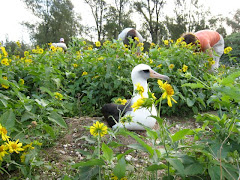But after hearing the story of Laysan ducks from the one and only John Klavitter (Wildlife Biologist with the U.S. Fish and Wildlife Service), I can appreciate their presence here. They are one of only three native ducks/geese left in Hawai`i, along with koloa and nene. Eight other species have gone extinct and the Laysan duck was casted to be the ninth. It came one animal away from extinction!

Once found throughout the Hawaiian Archipelago, the ducks were reduced to a single colony on Laysan island: 10 males, 1 female. Huge efforts went in to habitat restoration, monitoring, and medical intervention. The population quickly flourished and Laysan was soon full to capacity with them. So, in order to diversify their distribution, researchers created new habitats on Midway. They dug a few feet down through the concrete and coral to the water table, creating wetlands from freshwater seeps, landscaped with makaloa and native bunch grass. Eventually, 21 ducks were brought in and all survived the translocation. To everyone’s surprise, the one-year old ducks reproduced offspring that spring. Each year since then, the population has doubled.
Now they face a new challenge. Avian botulism, a disease caused by toxins from warm-water bacteria, broke out in the hot summer of 2008. The disease attacks the nervous system and causes an inability for the ducks to lift their heads. Many drown. Nearly half the Midway population was lost last summer. Then, this past Saturday, as summer temperatures rose, the first case in 2009 was reported.
This afternoon, John Klavitter treated one duck with a vaccine. Meanwhile, the “dead albatross undertaker” and others are collecting albatross fledgling corpses across the island to prevent the possibility of maggots carrying the now isolated disease around the island.
I still can’t tell the difference between all these terns and noddies and shearwaters, but the Laysan duck has captured my heart.
Photo credit: Dani Carter

















No comments:
Post a Comment